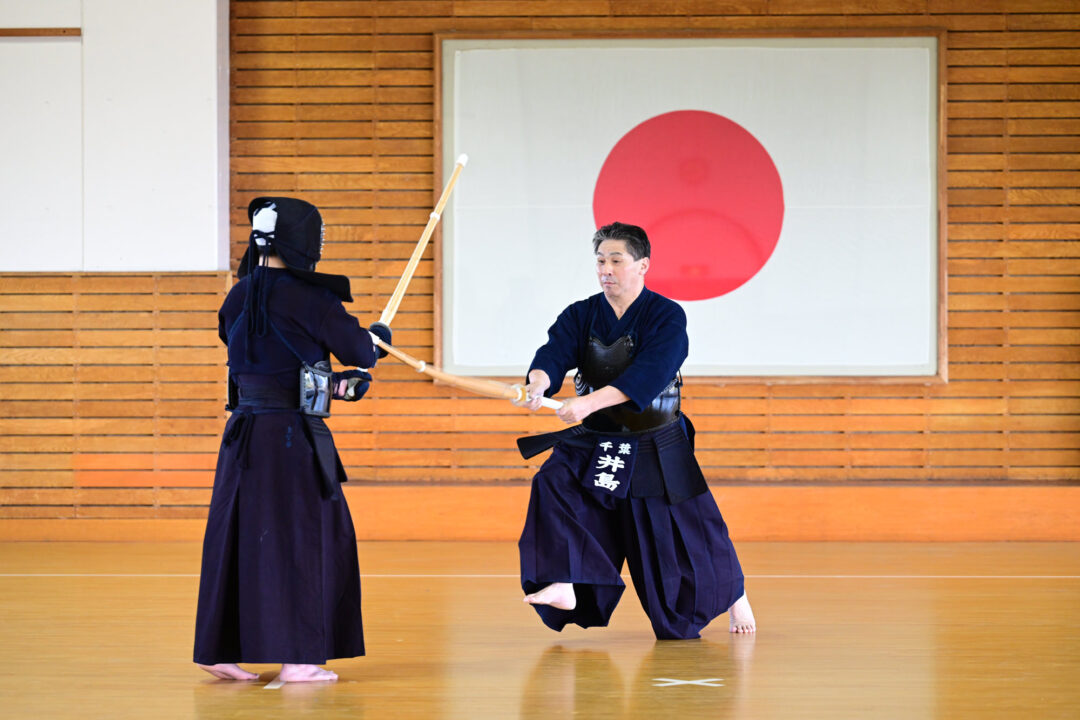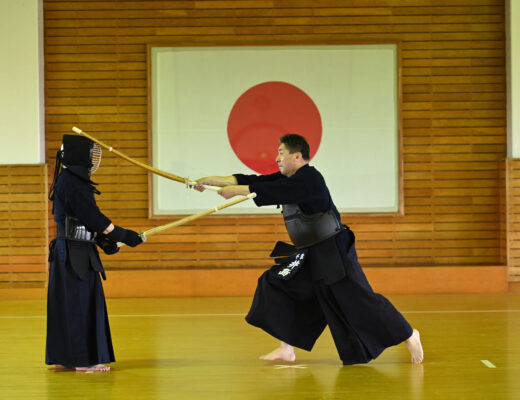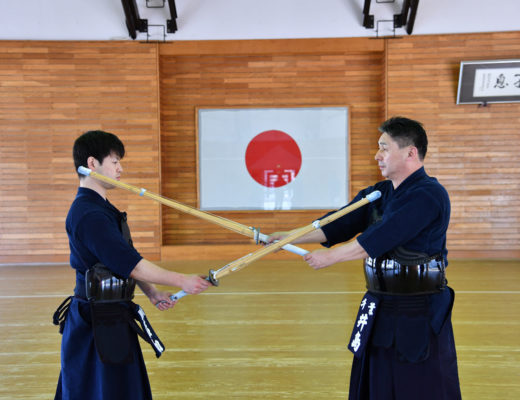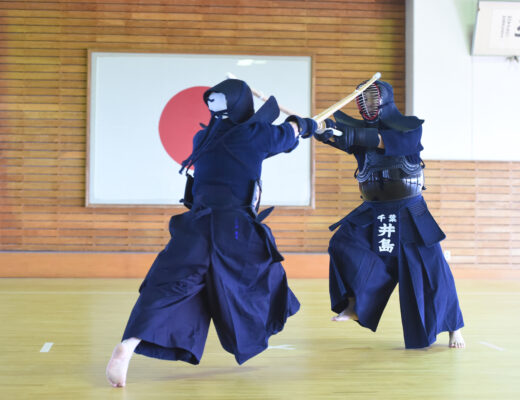2023.6 KENDOJIDAI
Composition: Tsuchiya Tomohiro
Photography: Nishiguchi Kunihiko
Translation: Pepijn Boomgaard
Just moving the feet is not the only aspect of footwork in Kendo. Your Ashi-sabaki should be in harmony with your hips, hands and gaze, as well as other aspects of your Kamae. It is also important to synchronize it with your breathing and mind. Ijima Sensei, who has trained many Kendoka since the opening of International Budo University, shared his thoughts on the subject.
Ijima Akira (Kyoshi 8th Dan)
Born in 1957 in Akita prefecture. Went to Honjo High School and Nippon Sport Science University. After working as research assistant at Nippon Sport Science University, he started working at International Budo University. He has been the coach of both the men’s and ladies Kendo teams. Currently, he is a professor at International Budo University and the head of the Kendo club. His achievements include participating in the All Japan 8th Dan Tournament, the All Japan Teachers Tournament and the All Japan Tozai Taiko Tournament.
In Kendo we have the saying Ichigan Nisoku Santan Shiriki (一眼二足三胆四力), which means the eyes (observation) first, the feet second, courage third and strength fourth. Much importance is placed on the use of our feet. When we talk about Ashi-sabaki, we tend to think only about moving our feet. However, unless we connect it to the other parts of our body, we have not mastered true Ashi-sabaki. It is important to learn the four basic forms of footwork: Ayumi-ashi, Okuri-ashi, Hiraki-ashi, and Tsugi-ashi. We do this through constant repetition. We should keep the position and preparation of our hips, the state and position of our left hand, and our gaze in mind when we move our feet. Rather than putting your left hip into it, you should align your own body with your opponent’s body. It is important to keep your left hand firmly in the center and move it in unison with your hips. Your gaze should not move up or down. You should move your feet smoothly without breaking your Kamae.
One thing to keep in mind is to put as little strength into your toes as possible. If you center your movements around the ball of the left foot* and focus on footwork, you can move smoothly and efficiently. It is important to subtly adjust the amount of strength you put into your right foot, and be aware that this is your Seme-ashi (the foot that you use to pressure). This will allow you to instantly respond to striking opportunities and build up Tame as well.
The left foot is intertwined with the right foot, and it always follows up the right foot. . The basic approach involves starting with the right foot and having the left foot follow. However, some individuals may consciously move both feet when the right foot advances. This trend is particularly noticeable in recent Kendo, especially among the younger generation. The first step is to thoroughly familiarize your body with the basic Ashi-sabaki. Next comes moving your feet together with an opponent. This allows us to check to see if we are able to use the four forms of Ashi-sabaki in an opportunistic manner. This can be said to be the application of Ashi-sabaki.
Let’s look at how we can implement this in Keiko. At the International Budo University, we have our students practice Ashi-sabaki, especially forward and backward. The instructor uses a Taiko drum. Whenever they hit the drum, the students have to switch from forward to backwards footwork, and vice versa. By using external cues rather than performing a predetermined number of steps, we hope they can learn how to move their feet instantly. The point is to repeatedly practice this while keeping in mind the key points we have touched on so far.
It is important to adapt your training to your level. As we grow older, it becomes harder to move our legs, but deciding how we deal with this is also an important aspect of Kendo. Many people aim to perform their Ashi-sabaki quickly, but by pursuing correct footwork rather than speed, we can learn more optimized movement and Ashi-sabaki. Performing accurately is about ingraining into the body. In other words, quality of quantity. This is not limited to just footwork.
So far, we have discussed performing Ashi-sabaki by ourselves. However, Kendo is a duel, and the Ashi-sabaki you use when your opponent comes at you is also important. This means not only moving forward and backward, but also using diagonal footwork and Hiraki-ashi when we perform Oji-waza. It is necessary to be able to respond to any situation. Even though Oji-waza is considered a form of Go No Sen*, the intent must be to initiate nonetheless. One must nurture the ability to anticipate the opponent’s actions and develop the ability to make the opponent move. It is important to integrate your footwork while cultivating these skills. Reading and moving the opponent and predicting their movements are considered to be high level concepts, but by pursuing these skills we can learn about the back-and-forth we have with our opponent and the use of different techniques. It will provide an opportunity to deeply learn about Kendo.
If you can’t demonstrate these skills in Jigeiko, Shiai or Dan examinations, you cannot say that you have truly mastered correct Ashi-sabaki. I would go as far as to say that practicing your footwork rather than swinging your Shinai will lead to better results.
In recent Dan examinations, women and adults approaching middle age stood out to me. Even if you manage to seize an opportunity and strike, it will look like you are only striking with your arms if you do not have to correct footwork. Some people also bump into their opponent after they strike and lose their posture because their footwork is not up to par. If you have correct footwork, you can avoid these kinds of unforeseen situations.
If aging adults continue to pursue the Kendo that they did when they were younger, they may overdo it, leading to injuries. It is important for older people to adapt footwork appropriate for their age and to engage in Keiko while always checking their Ashi-sabaki.
Having skilled footwork is not limited to only younger practitioners. In fact, there are many older Sensei who’s footwork we should look up to. The sharpness of their Ashi-sabaki and techniques has been a guiding principle in my Kendo journey.
Linking your footwork to your Kamae and lower abdomen
The rest of this article is only available for Kendo Jidai International subscribers!





